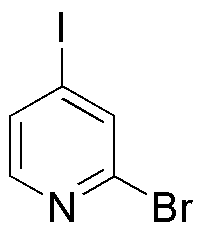2-Bromo-4-iodopyridine is widely utilized in research focused on:
- Synthesis of Pharmaceuticals: This compound serves as a key intermediate in the synthesis of various pharmaceuticals, particularly in the development of anti-cancer and anti-inflammatory drugs.
- Organic Electronics: It is used in the production of organic semiconductors, which are essential for manufacturing flexible electronic devices, such as OLEDs (Organic Light Emitting Diodes).
- Research in Agrochemicals: The compound plays a role in the development of agrochemicals, including herbicides and pesticides, helping to improve crop yields and pest resistance.
- Material Science: It is employed in creating novel materials with specific electronic and optical properties, which can be used in sensors and advanced coatings.
- Bioconjugation Techniques: This chemical is utilized in bioconjugation reactions, aiding in the labeling and tracking of biomolecules for research in biochemistry and molecular biology.
General Information
Properties
Safety and Regulations
Applications
2-Bromo-4-iodopyridine is widely utilized in research focused on:
- Synthesis of Pharmaceuticals: This compound serves as a key intermediate in the synthesis of various pharmaceuticals, particularly in the development of anti-cancer and anti-inflammatory drugs.
- Organic Electronics: It is used in the production of organic semiconductors, which are essential for manufacturing flexible electronic devices, such as OLEDs (Organic Light Emitting Diodes).
- Research in Agrochemicals: The compound plays a role in the development of agrochemicals, including herbicides and pesticides, helping to improve crop yields and pest resistance.
- Material Science: It is employed in creating novel materials with specific electronic and optical properties, which can be used in sensors and advanced coatings.
- Bioconjugation Techniques: This chemical is utilized in bioconjugation reactions, aiding in the labeling and tracking of biomolecules for research in biochemistry and molecular biology.
Documents
Safety Data Sheets (SDS)
The SDS provides comprehensive safety information on handling, storage, and disposal of the product.
Product Specification (PS)
The PS provides a comprehensive breakdown of the product’s properties, including chemical composition, physical state, purity, and storage requirements. It also details acceptable quality ranges and the product's intended applications.
Certificates of Analysis (COA)
Search for Certificates of Analysis (COA) by entering the products Lot Number. Lot and Batch Numbers can be found on a product’s label following the words ‘Lot’ or ‘Batch’.
Numéro de catalogue
Numéro de lot/série
Certificates Of Origin (COO)
This COO confirms the country where the product was manufactured, and also details the materials and components used in it and whether it is derived from natural, synthetic, or other specific sources. This certificate may be required for customs, trade, and regulatory compliance.
Numéro de catalogue
Numéro de lot/série
Safety Data Sheets (SDS)
The SDS provides comprehensive safety information on handling, storage, and disposal of the product.
DownloadProduct Specification (PS)
The PS provides a comprehensive breakdown of the product’s properties, including chemical composition, physical state, purity, and storage requirements. It also details acceptable quality ranges and the product's intended applications.
DownloadCertificates of Analysis (COA)
Search for Certificates of Analysis (COA) by entering the products Lot Number. Lot and Batch Numbers can be found on a product’s label following the words ‘Lot’ or ‘Batch’.
Numéro de catalogue
Numéro de lot/série
Certificates Of Origin (COO)
This COO confirms the country where the product was manufactured, and also details the materials and components used in it and whether it is derived from natural, synthetic, or other specific sources. This certificate may be required for customs, trade, and regulatory compliance.


